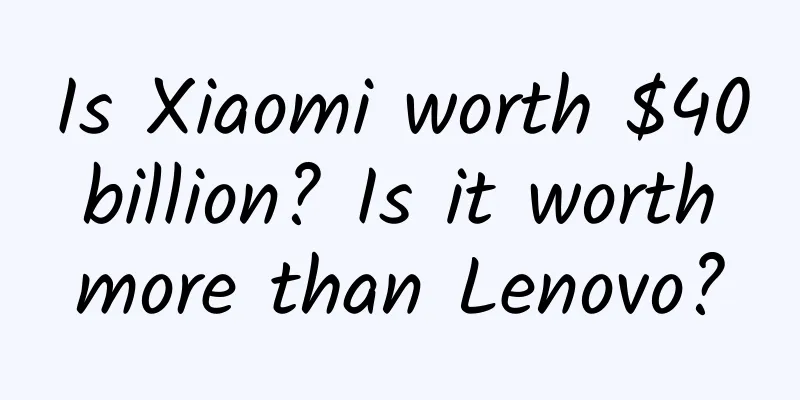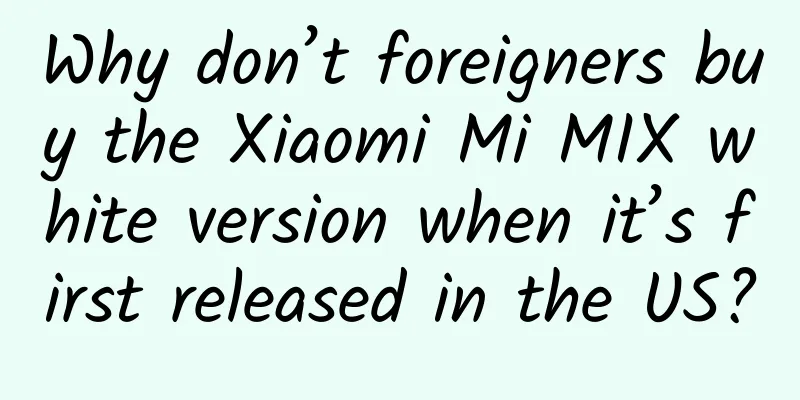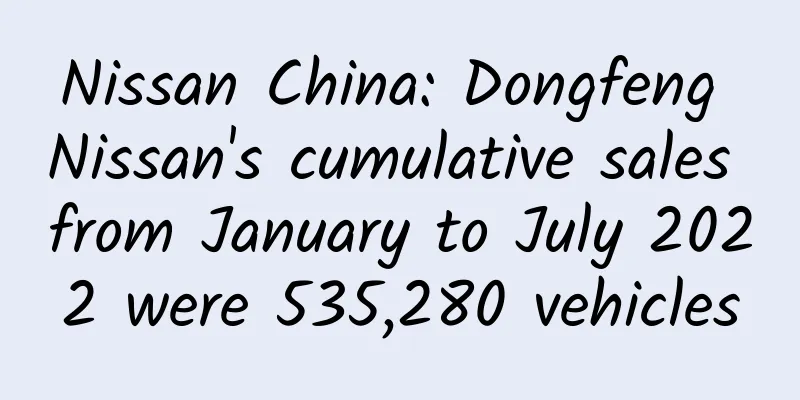Is Xiaomi worth $40 billion? Is it worth more than Lenovo?

|
After Xiaomi ranked third in the global smartphone market in the third quarter, foreign media reported that Xiaomi wanted to raise funds again at a valuation of $40 billion after rejecting a financing offer at a valuation of $30 billion. We do not want to analyze whether Xiaomi's current valuation is worth $40 billion, but because this valuation far exceeds Lenovo (Lenovo's current market value is about $15.6 billion), it has to raise our doubts. It is undeniable that Xiaomi has achieved rapid development in the field of mobile Internet (mainly the smartphone market), as can be seen from the growing market share and ranking of its main business smartphones in China and even globally, as well as its revenue. However, there is still a big gap compared with Lenovo. First of all, from the revenue scale, according to relevant reports, in the first half of 2014, Xiaomi's revenue was about 5.31 billion US dollars, an increase of about 150% over the same period last year. Xiaomi insiders expect that the company's revenue for the whole year this year will exceed 11 billion US dollars. In comparison, Lenovo's revenue in just one quarter of this year reached 10.395 billion US dollars, and its revenue last year was 38.7 billion US dollars. Even if Xiaomi's revenue can reach 11 billion US dollars this year, it is only about 1/4 of Lenovo's at best, of course, this is not counting the revenue from Lenovo's acquisition of IBM's X86 server business and Motorola's mobile business (both acquisitions have been announced to be completed). As for profits, since Xiaomi has not announced it, we cannot make an effective comparison, but we know that Lenovo's net profit last year was 817 million US dollars, and the net profit in the latest quarter of this year was 214 million US dollars. Those in the industry who know Xiaomi's profits can make a comparison. Secondly, the business scale. If Lenovo’s core business was traditional PCs before, Lenovo has now formed a complete PC strategic layout through mergers and acquisitions and its own efforts, namely, PCs, mobile Internet (smartphones and tablets), and enterprise-level businesses. More importantly, in addition to Lenovo’s current position as the leader in the traditional PC industry, it is also in the forefront (at least in the top five) in the mobile Internet industry represented by smartphones and tablets. As for the enterprise market, at least in the server market, Lenovo has also entered the top three in the world through mergers and acquisitions. In contrast, Xiaomi only has smartphones as its main business. Although it is also trying to expand its business scope, it is far behind Lenovo in terms of the influence of Lenovo’s business expansion in related fields and the actual market scale it has obtained. In addition to the above-mentioned gap in scale (volume), let us look at whether the similarities and differences between the two parties lead to a large gap between Xiaomi's valuation and Lenovo's market value from the perspective of industrial competition. As analyzed above, the smartphone industry is the core of Xiaomi's current business. However, from the development trend of the entire smartphone industry, the slowdown in growth and low-priced phones have become the driving force for development. In addition, the "Xiaomi model" that made Xiaomi successful has been imitated by competitors (no matter how effective the imitation is, it will dilute the success of the Xiaomi model). The competition Xiaomi encounters in this industry will only become more and more fierce. In the future, it will face the choice of scale and profit (either high profit margin or scale in exchange for profit). However, what we want to say here is that, at least from the current perspective, apart from Apple, few manufacturers can survive and develop with high profit margins. The most feasible way is to increase total profit through scale. In fact, since Xiaomi released the low-priced Redmi and it replaced Xiaomi mobile phones as the main shipment, Xiaomi has embarked on a large-scale business model. In other words, the sales volume of small-hand mobile phones (including Xiaomi and Redmi) will be crucial in the future. In this case, let's compare the gap in scale between Xiaomi and Lenovo. Although Xiaomi entered the top three global smartphones in the third quarter, with the completion of the acquisition of Motorola Mobility, Lenovo has actually replaced Xiaomi as the third in the world's smartphones, and has widened the gap with Xiaomi. What we need to emphasize is that the smartphone business is only one of Lenovo's three major businesses, and it is still not Lenovo's core business, while for Xiaomi it means the core, or even all. Imagine that the non-core business of one company is ahead of the core business of another company, and the industry characteristics of the business or the main factor that determines the outcome is scale. It should not be difficult to conclude who is stronger and who is weaker. More importantly, from the perspective of industry competition, with the withdrawal of manufacturers and the irreplaceable and gradually stabilizing industry, the degree of competition is actually weakening (at least compared with the smartphone industry where Xiaomi's core business is located). This industry characteristic will make Lenovo's core business and its position as the leader more stable, and provide continuous backup power for its continued efforts in the smartphone industry. Similarly, Lenovo's other enterprise-level business is similar to the PC industry, with less competitive intensity than the smartphone industry, and the industry is relatively stable. Of course, some people may say that Xiaomi's future lies in its software and services (commonly known as Xiaomi's triathlon in the industry), that is, Xiaomi does not make money from mobile phone hardware itself, but from software and services, as well as related accessories. We don't want to argue too much about this. When it comes to software and services (based on the smartphone ecosystem), Apple should be the best, and they also have two independent businesses, tablets and Macs. But from Apple's entire revenue and profit structure, iPhone (sales of mobile phone hardware) accounts for about 60%-70%, which is why the industry jokingly calls Apple the iPhone company. Since Apple is making money from hardware, how does Xiaomi make money from software and services? Moreover, let's ask Xiaomi, in its current revenue and profit structure, which of the so-called triathlons accounts for the majority? So the question is, is Xiaomi worth a valuation of $40 billion? Perhaps some experts will come to the conclusion that it is. However, since its valuation is much higher than Lenovo, and Lenovo and Xiaomi are in a very close competitive relationship in Xiaomi's core business, we use Lenovo's market value as a reference, and combined with the scale of both companies, especially the competitive characteristics and trends of the industries they are in, we believe that Xiaomi's valuation of $40 billion is indeed too high. As a winner of Toutiao's Qingyun Plan and Baijiahao's Bai+ Plan, the 2019 Baidu Digital Author of the Year, the Baijiahao's Most Popular Author in the Technology Field, the 2019 Sogou Technology and Culture Author, and the 2021 Baijiahao Quarterly Influential Creator, he has won many awards, including the 2013 Sohu Best Industry Media Person, the 2015 China New Media Entrepreneurship Competition Beijing Third Place, the 2015 Guangmang Experience Award, the 2015 China New Media Entrepreneurship Competition Finals Third Place, and the 2018 Baidu Dynamic Annual Powerful Celebrity. |
<<: Renren sells off 56.com: after the bloat, only depression remains
>>: To Xiaomi: Blessings and disasters lie somewhere in between
Recommend
How does Zhihu build its brand?
How does a brand , starting from its brand name a...
What are the online promotion channels?
What are the common online channels ? There are m...
TrendForce: Power battery demand and prices to remain stable in May 2024, prices to fall in June
According to the latest research by TrendForce, a...
Beware! Several major killers that have taken away the health of hundreds of millions of Chinese people are seriously threatening your life span! !
Readers who often read popular science articles k...
Yin Chen's four new courses in 2022, 2022 algorithm disassembly and gameplay analysis, Qianchuan's 100 questions practical disassembly
Yin Chen's four new courses in 2022, 2022 alg...
Which is more damaging to the battery, charging your phone to 10% or 90%?
I always thought that The biggest harm to mobile ...
The nucleic acid test sampling cotton swab contains carcinogens? Here comes the rumor debunking!
[This issue's rumors]: Recently, rumors that ...
How did life originate? High-energy particles from the sun may be the key
How did life on Earth begin? This is one of the g...
【Food Information】Food Recipe Tutorial Collection Document
【Food Information】Food recipe tutorial collection...
How Google's Universal Search Ranking Works: Search Is Much More Than PPC
Introduction Since Google introduced the universa...
How to run a successful social media marketing campaign?
Product sales are not increasing? Sale! User purc...
This infectious disease is still spreading! Be careful when you go swimming or playing in the water!
Where are the most crowded places in summer? That...
What are the functions of the designated driver mini program? How much does it cost to make a designated driver app?
Nowadays, the country’s control over drunk drivin...
If humans became as small as insects, could they still rule the earth?
It took humans only 3 million years to achieve th...
Plant a dam and “water” a friend!
March brings everything back to life Planting flo...









